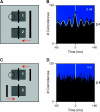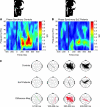The role of oscillations and synchrony in cortical networks and their putative relevance for the pathophysiology of schizophrenia
- PMID: 18562344
- PMCID: PMC2632472
- DOI: 10.1093/schbul/sbn062
The role of oscillations and synchrony in cortical networks and their putative relevance for the pathophysiology of schizophrenia
Abstract
Neural oscillations and their synchronization may represent a versatile signal to realize flexible communication within and between cortical areas. By now, there is extensive evidence to suggest that cognitive functions depending on coordination of distributed neural responses, such as perceptual grouping, attention-dependent stimulus selection, subsystem integration, working memory, and consciousness, are associated with synchronized oscillatory activity in the theta-, alpha-, beta-, and gamma-band, suggesting a functional mechanism of neural oscillations in cortical networks. In addition to their role in normal brain functioning, there is increasing evidence that altered oscillatory activity may be associated with certain neuropsychiatric disorders, such as schizophrenia, that involve dysfunctional cognition and behavior. In the following article, we aim to summarize the evidence on the role of neural oscillations during normal brain functioning and their relationship to cognitive processes. In the second part, we review research that has examined oscillatory activity during cognitive and behavioral tasks in schizophrenia. These studies suggest that schizophrenia involves abnormal oscillations and synchrony that are related to cognitive dysfunctions and some of the symptoms of the disorder. Perspectives for future research will be discussed in relationship to methodological issues, the utility of neural oscillations as a biomarker, and the neurodevelopmental hypothesis of schizophrenia.
Figures


Similar articles
-
High-frequency oscillations in schizophrenia.Clin EEG Neurosci. 2011 Apr;42(2):77-82. doi: 10.1177/155005941104200208. Clin EEG Neurosci. 2011. PMID: 21675597
-
Brain functional connectivity and the pathophysiology of schizophrenia.Psychiatriki. 2014 Apr-Jun;25(2):91-4. Psychiatriki. 2014. PMID: 25035177 English, Greek, Modern.
-
High vs low frequency neural oscillations in schizophrenia.Schizophr Bull. 2011 Jul;37(4):659-63. doi: 10.1093/schbul/sbr056. Epub 2011 Jun 7. Schizophr Bull. 2011. PMID: 21653278 Free PMC article. Review.
-
Abnormal neural oscillations and synchrony in schizophrenia.Nat Rev Neurosci. 2010 Feb;11(2):100-13. doi: 10.1038/nrn2774. Nat Rev Neurosci. 2010. PMID: 20087360 Review.
-
High-frequency oscillations and the neurobiology of schizophrenia.Dialogues Clin Neurosci. 2013 Sep;15(3):301-13. doi: 10.31887/DCNS.2013.15.3/puhlhaas. Dialogues Clin Neurosci. 2013. PMID: 24174902 Free PMC article. Review.
Cited by
-
40-Hz Auditory Steady-State Response (ASSR) as a Biomarker of Genetic Defects in the SHANK3 Gene: A Case Report of 15-Year-Old Girl with a Rare Partial SHANK3 Duplication.Int J Mol Sci. 2021 Feb 14;22(4):1898. doi: 10.3390/ijms22041898. Int J Mol Sci. 2021. PMID: 33673024 Free PMC article.
-
Regulating prefrontal cortex activation: an emerging role for the 5-HT₂A serotonin receptor in the modulation of emotion-based actions?Mol Neurobiol. 2013 Dec;48(3):841-53. doi: 10.1007/s12035-013-8472-0. Epub 2013 May 22. Mol Neurobiol. 2013. PMID: 23696058 Review.
-
Bridging the Gap between Genes and Language Deficits in Schizophrenia: An Oscillopathic Approach.Front Hum Neurosci. 2016 Aug 23;10:422. doi: 10.3389/fnhum.2016.00422. eCollection 2016. Front Hum Neurosci. 2016. PMID: 27601987 Free PMC article.
-
Toward a neurobiology of delusions.Prog Neurobiol. 2010 Nov;92(3):345-69. doi: 10.1016/j.pneurobio.2010.06.007. Epub 2010 Jun 15. Prog Neurobiol. 2010. PMID: 20558235 Free PMC article. Review.
-
Resting state electroencephalogram oscillatory abnormalities in schizophrenia and psychotic bipolar patients and their relatives from the bipolar and schizophrenia network on intermediate phenotypes study.Biol Psychiatry. 2014 Sep 15;76(6):456-65. doi: 10.1016/j.biopsych.2013.12.008. Epub 2013 Dec 24. Biol Psychiatry. 2014. PMID: 24439302 Free PMC article.
References
-
- Berger H. Ueber das Electrocephalogramm des Menschen. Arch Psychiatr Nervenkr. 1929;87:527–570.
-
- Le Van Quyen M, Bragin A. Analysis of dynamic brain oscillations: methodological advances. Trends Neurosci. 2007;30:365–373. - PubMed
-
- Buzsaki G, Draguhn A. Neuronal oscillations in cortical networks. Science. 2004;304:1926–1929. - PubMed
-
- Fries P, Nikolić D, Singer W. The gamma cycle. Trends Neurosci. 2007;30:309–316. - PubMed
-
- Singer W. Neuronal synchrony: a versatile code for the definition of relations? Neuron. 1999;24:49–65. 111–125. - PubMed
Publication types
MeSH terms
LinkOut - more resources
Full Text Sources
Other Literature Sources
Medical

